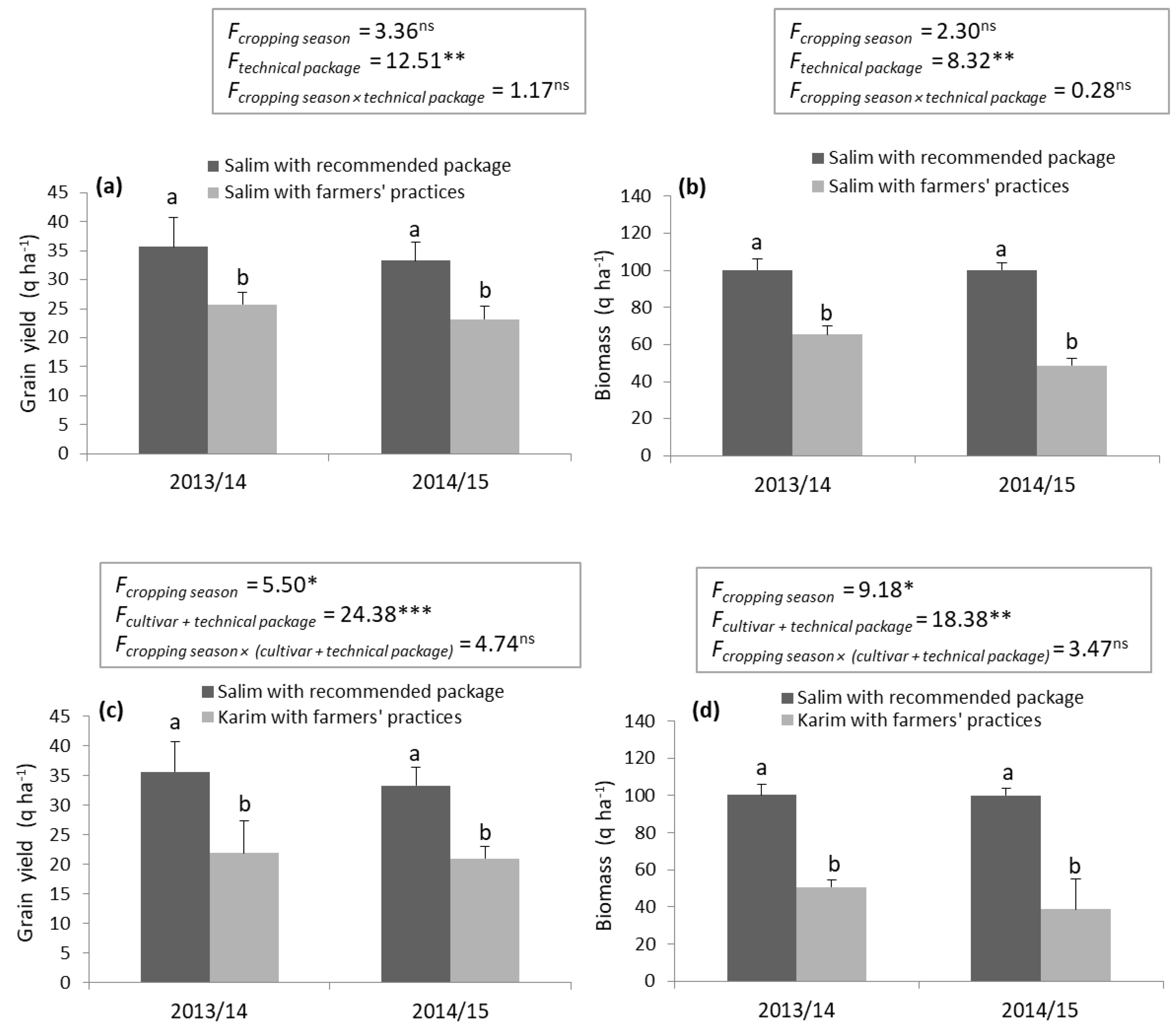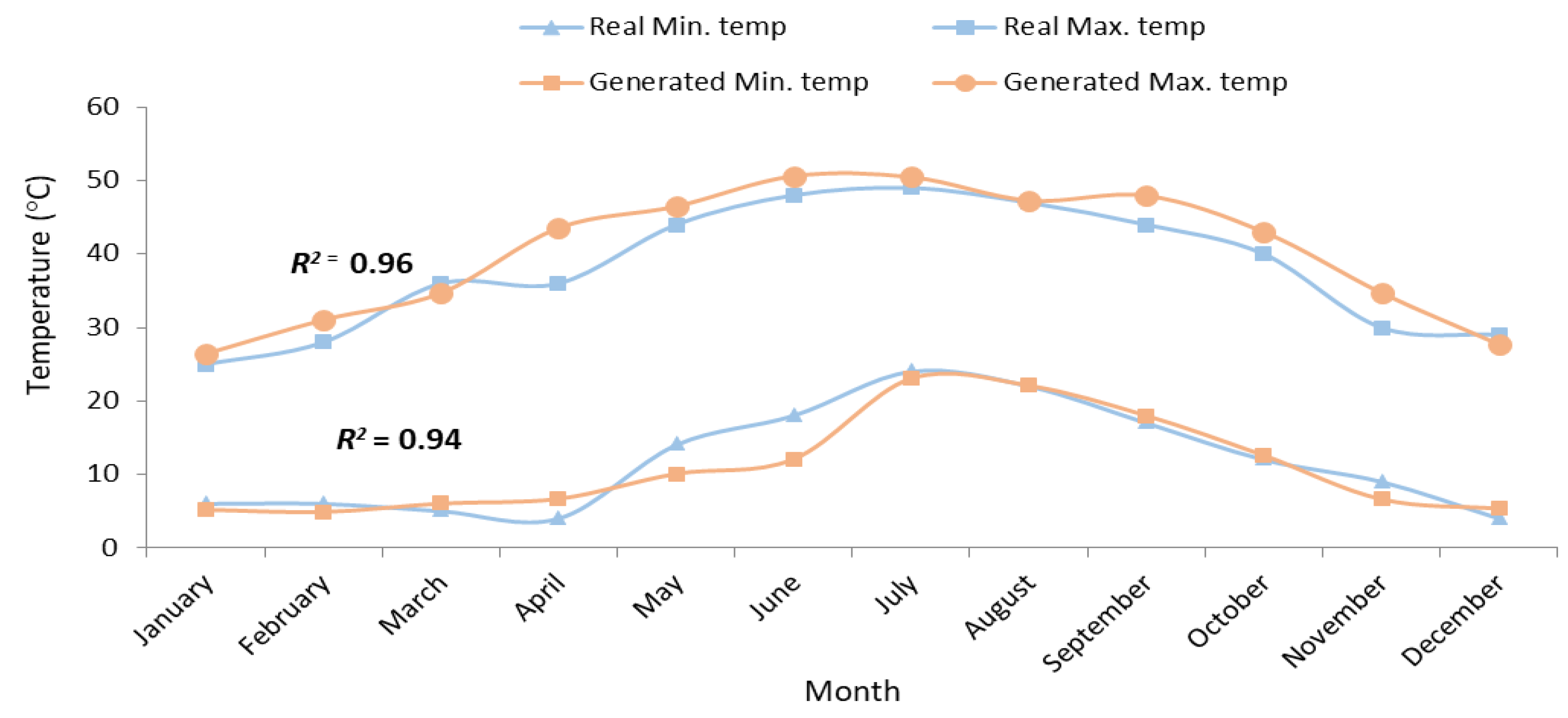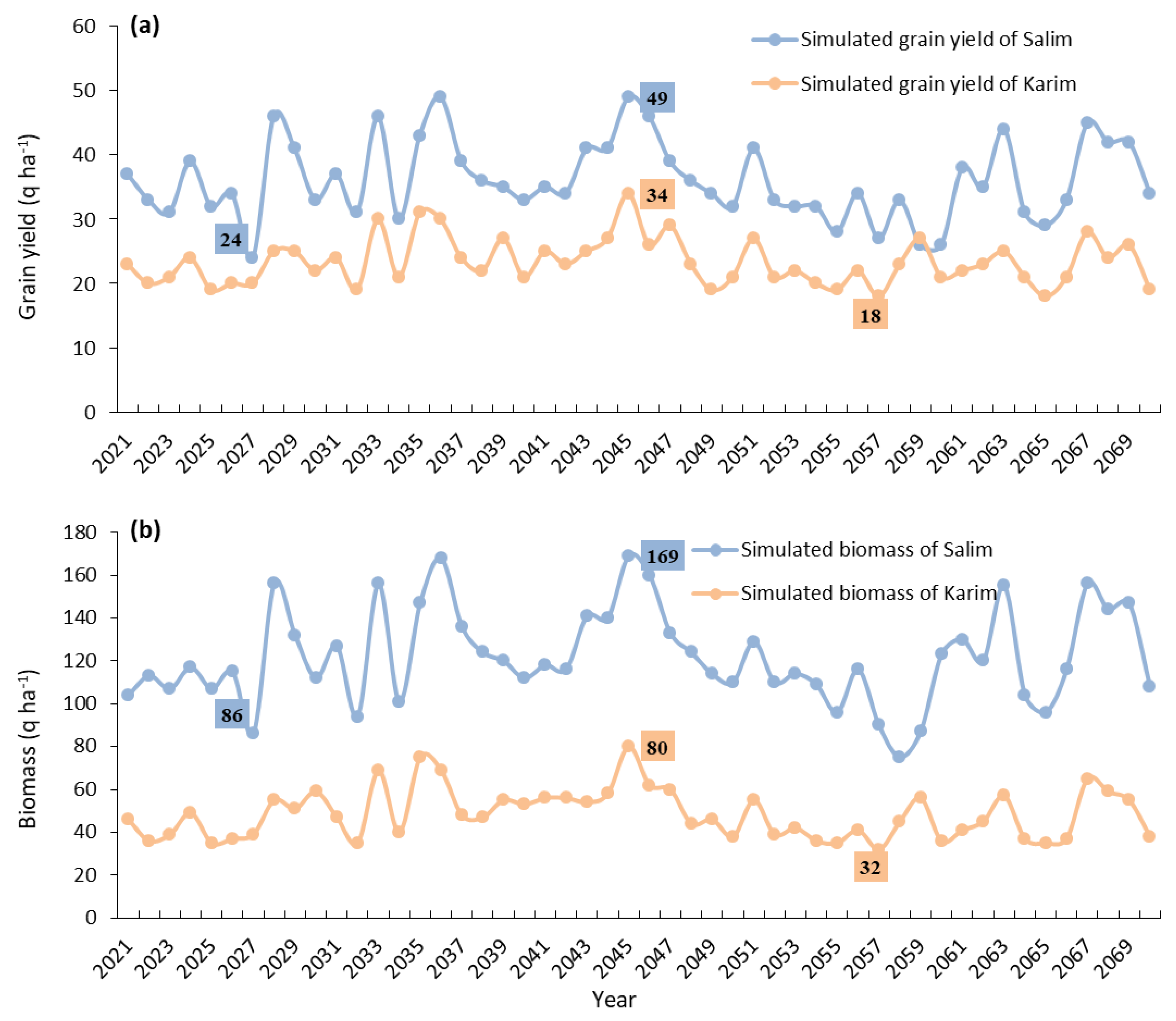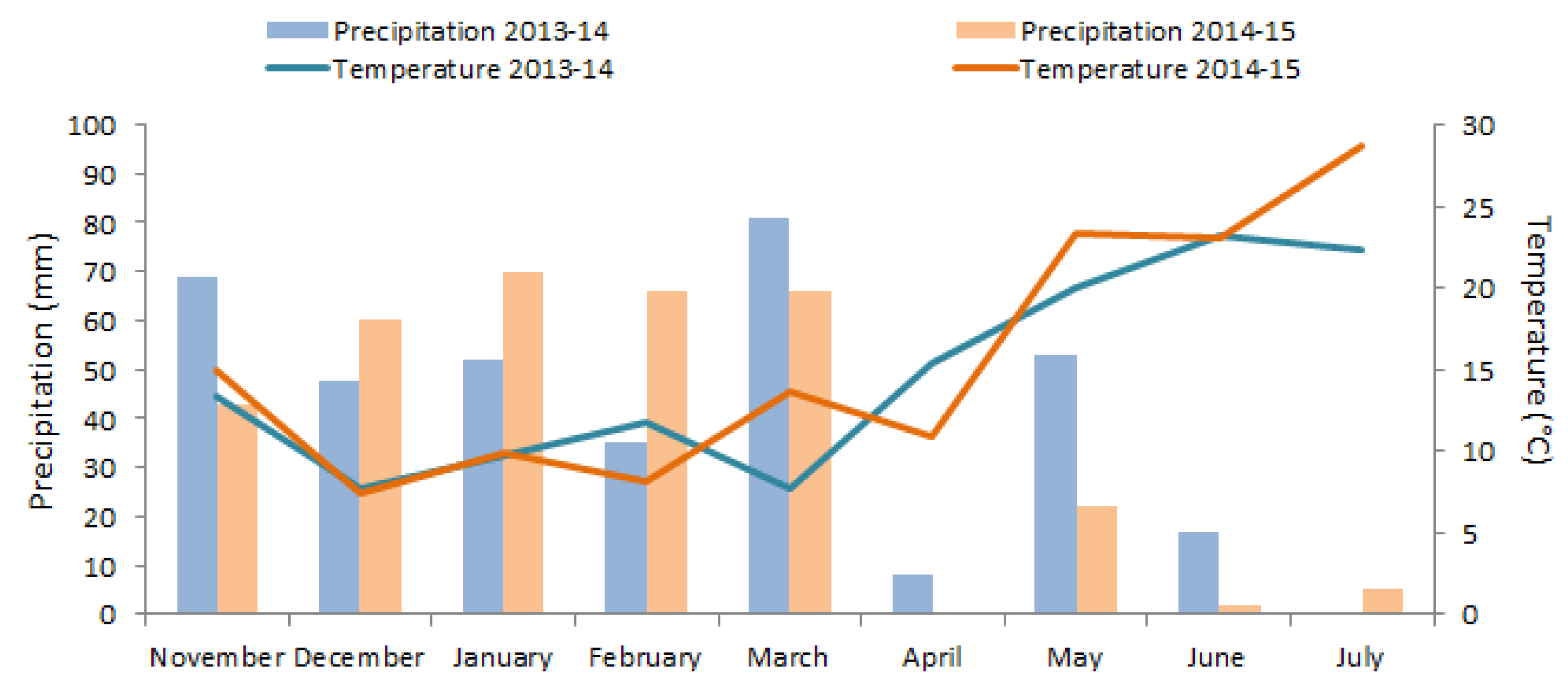Adoption of Durum Wheat Cultivar ‘Salim’ with a Technical Package and Its Resilience to Climate Change Impacts in Smallholders: Case of Nebeur/Kef Region, Tunisia
Abstract
1. Introduction
2. Results and Discussion
2.1. On-Farm Demonstration of ‘Salim’ Durum Wheat Cultivar
2.2. Transfer of Durum Wheat Technical Package
2.3. Adoption of ‘Salim’ with the Recommended Technical Package vs. ‘Karim’ with Farmers’ Practices
2.4. Generated Temperature and Precipitation
2.5. Short-Term Grain Yield and Biomass Simulation
2.6. Long-Term Grain Yield and Biomass Simulation
3. Materials and Methods
3.1. Site Description and Meteorological Data Collection
3.2. Experimental Procedures
3.3. Plant Measurements
3.4. CropSyst Model Description
3.5. Input Data and Weather Generation
3.6. Short-Term Yield and Biomass Simulations
3.7. Long-Term Yield and Biomass Simulations
4. Conclusions
Supplementary Materials
Author Contributions
Funding
Institutional Review Board Statement
Informed Consent Statement
Data Availability Statement
Acknowledgments
Conflicts of Interest
References
- Sabella, E.; Aprile, A.; Negro, C.; Nicolì, F.; Nutricati, E.; Vergine, M.; Luvisi, A.; De Bellis, L. Impact of climate change on durum wheat yield. Agronomy 2020, 10, 793. [Google Scholar] [CrossRef]
- Beres, B.L.; Rahmani, E.; Clarke, J.M.; Grassini, P.; Posniak, C.J.; Geddes, C.M.; Porker, K.D.; May, W.E.; Ranson, J.K. A systematic review of durum wheat: Enhancing production systems by exploring genotype, environment, and management (G × E × M) synergies. Front. Plant Sci. 2020, 11, 568657. [Google Scholar] [CrossRef] [PubMed]
- Sadok, W.; Schoppach, R.; Ghanem, M.E.; Zucca, C.; Sinclair, T.R. Wheat drought-tolerance to enhance food security in Tunisia, birthplace of the Arab Spring. Eur. J. Agron. 2019, 107, 1–9. [Google Scholar] [CrossRef]
- Chahed, Y. Tunisia Grain, Grain and Feed Annual; Grain Report; USDA Foreign Agriculture Service: Washington, DC, USA, 2009. [Google Scholar]
- Lizumia, T.; Ramankutty, N. How do weather and climate influence cropping area and intensity? Glob. Food Sec. 2015, 4, 46–50. [Google Scholar]
- Sommer, R.; Glazirina, M.; Yuldashev, T.; Otarov, A.; Ibraeva, M.; Martynova, L.; Bekenov, M.; Kholov, B.; Ibragimov, M.; Kobilov, R.; et al. Impact of climate change on wheat productivity in Central Asia. Agric. Ecosyst. Environ. 2013, 178, 78–99. [Google Scholar] [CrossRef]
- Moriondo, M.; Bindi, M.; Brilli, L.; Costafreda-Aumedes, S.; Dibari, C.; Leolini, L.; Padovan, G.; Trombi, G.; Karali, A.; Varotsos, K.V.; et al. Assessing climate change impacts on crops by adopting a set of crop performance indicators. EMJE 2021, 6, 45. [Google Scholar]
- Bahri, H.; Annabi, M.; M’Hamed, H.C.; Frija, A. Assessing the long-term impact of conservation agriculture on wheat-based systems in Tunisia using APSIM simulations under a climate change context. Sci. Total. Environ. 2019, 692, 1223–1233. [Google Scholar] [CrossRef]
- Richardson, J.G. On-farm demonstrations: Consideration factors for their success and viability as an extension teaching tool. SASAE 2003, 32, 114–124. [Google Scholar]
- Mueller, N.D.; Gerber, J.S.; Johnston, M.; Ray, K.D.; Ramankutty, N.; Foley, J.A. Closing yield gaps through nutrient and water management. Nature 2013, 490, 254–257. [Google Scholar] [CrossRef] [PubMed]
- El Harizi, K.; Sparacino, C.; M’Barek, S.B. Tunisie: Quel Avenir Pour les Cooperatives Agricoles? Organisation des Nations Unies Pour l’Alimentation et l’Agriculture: Rome, Italy, 2019; pp. 69–78. [Google Scholar]
- Neumann, K.; Verburg, P.H.; Stehfest, E.; Müller, C. The yield gap of global grain production: A spatial analysis. Agric. Syst. 2010, 103, 316–326. [Google Scholar] [CrossRef]
- Deghaïs, M.; Kouki, M.; Gharbi, M.; El Felah, M. Les Variétés de Céréales Cultivées en Tunisie (blé Dur, blé Tendre, orge et Triticale); Ministère de l’Agriculture et des Ressources en Eau: Tunis, Tunisie, 2007; pp. 1–445. [Google Scholar]
- Ayed, S. (National Agricultural Research Institute of Tunisia, Ariana, Tunisia). Personal communication, 2021.
- Mwadzingeni, L.; Shimelis, H.; Dube, E.; Laing, M.D.; Tsilo, T.J. Breeding wheat for drought tolerance: Progress and technologies. J. Integr. Agric. 2016, 15, 935–943. [Google Scholar] [CrossRef]
- Sheshshayee, S.M.; Vijayaraghavareddy, P.; Sreevathsa, R.; Rajendrareddy, S.; Arakesh, S.; Bharti, P.; Dharmappa, P.; Soolanayakanahally, R. Introgression of physiological traits for a comprehensive improvement of drought adaptation in crop plants. Front. Chem. 2018, 6, 92. [Google Scholar]
- Asfaw, S.; Shiferaw, B.; Simtowe, F.; Lipper, L. Impact of modern agricultural technologies on smallholder welfare: Evidence from Tanzania and Ethiopia. Food Policy 2012, 37, 283–295. [Google Scholar] [CrossRef]
- Aggarwal, P.K.; Hebbar, K.B.; Venugopalan, M.V.; Rani, S.; Bala, A.; Biswal, A.; Wani, S.P. Quantification of Yield Gaps in Rain-Fed Rice, Wheat, Cotton and Mustard in India. Global Theme on Agroecosystems Report No. 43; International Crops Research Institute for the Semi-Arid Tropics: Andhra Pradesh, India, 2008; pp. 1–36. [Google Scholar]
- Lobell, D.B.; Schlenker, W.; Costa-Roberts, J. Climate trends and global crop production since 1980. Science 2011, 333, 616–620. [Google Scholar] [CrossRef] [PubMed]
- Shi, W.; Tao, F.; Zhang, Z. A review on statistical models for identifying climate contributions to crop yields. J. Geogr. Sci. 2013, 23, 567–576. [Google Scholar] [CrossRef]
- Ahmad, I.; Saeed, U.; Fahad, M.; Ullah, A.; Habib ur Rahman, M.; Ahmad, A.; Judge, J. Yield forecasting of spring maize using remote sensing and crop modeling in Faisalabad-Punjab Pakistan. J. Indian Soc. Remote. Sens. 2018, 46, 1701–1711. [Google Scholar] [CrossRef]
- ur Rahman, M.H.; Ahmad, A.; Wang, X.; Wajid, A.; Nasim, W.; Hussain, M.; Ahmad, B.; Ahmad, I.; Ali, Z.; Ishaque, W.; et al. Multi-model projections of future climate and climate change impacts uncertainty assessment for cotton production in Pakistan. Agric. For. Meteorol. 2018, 253, 94–113. [Google Scholar] [CrossRef]
- Vanli, O.; Ustundag, B.B.; Ahmad, I.; Hernandez-Ochoa, I.M.; Hoogenboom, G. Using crop modeling to evaluate the impacts of climate change on wheat in southeastern turkey. Environ. Sci. Pollut. Res. 2019, 26, 29397–29408. [Google Scholar] [CrossRef]
- Najafi, E.; Devineni, N.; Khanbilvardi, R.M.; Kogan, F. Understanding the changes in global crop yields through changes in climate and technology. Earth’s Future 2018, 6, 410–427. [Google Scholar] [CrossRef]
- Zhao, C.; Liu, B.; Piao, S.; Wang, X.; Lobell, D.B.; Huang, Y.; Huang, M.; Yao, Y.; Bassu, S.; Ciais, P.; et al. Temperature increase reduces global yields of major crops in four independent estimates. Proc. Natl. Acad. Sci. USA 2017, 114, 9326–9331. [Google Scholar] [CrossRef] [PubMed]
- Berraies, S.; Ammar, K.; Gharbi, M.S.; Yahyaoui, A.; Rezgui, S. Quantitative inheritance of resistance to Septoria tritici blotch in durum wheat in Tunisia. Chil. J. Agric. Res. 2014, 74, 35–40. [Google Scholar] [CrossRef][Green Version]
- Tiwari, A.; Choudhary, S.; Manjhi, P.; Swarnakar, V.K. Compare the yield of wheat varieties provided under NAIP (National Agricultural Innovation Project) through IARI (Indian Agricultural Research Institute) in Dhar district of Madhya Pradesh, India. J. Agric. Vet. Sci. 2014, 7, 37–40. [Google Scholar] [CrossRef]
- Bekele, M.; Shiberu, T. Adoption of improved bread wheat varieties on small-scale farmers: The case of Boji Gebisa Ambo District, Oromia Regional State, Ethiopia. Am. J. Food Sci. Technol. 2014, 2, 103–108. [Google Scholar] [CrossRef]
- Ghimire, R.; Huang, W.; Shrestha, R.B. Factors affecting adoption of improved rice varieties among rural farm households in Central Nepal. Rice Sci. 2015, 22, 35–43. [Google Scholar] [CrossRef]
- Adzawla, W.; Alhassan, H. Effects of climate adaptation on technical efficiency of maize production in Northern Ghana. Agric. Food Econ. 2021, 9, 14. [Google Scholar] [CrossRef]
- Joshi, N.S.; Bariya, M.K.; Kunjadia, B.B. Yield gap analysis through front line demonstration in wheat crop. Int. J. Sci. Res. 2014, 4, 1–3. [Google Scholar]
- Eponou, T. Linkage between research and technology users: Some issues from Africa. ISNAR Brief. Pap. 1996, 30, 1–8. [Google Scholar]
- Bell, M.A.; Fischer, R.A.; Byerlee, D.; Sayre, K. Genetic and agronomic contributions to yield gains: A case study for wheat. Field Crop. Res. 1995, 44, 55–65. [Google Scholar] [CrossRef]
- Amamou, H.; Ben Sassi, M.; Aouadi, H.; Khemiri, H.; Mahouachi, M.; Beckers, Y.; Hammami, H. Climate change-related risks and adaptation strategies as perceived in dairy cattle farming systems in Tunisia. Clim. Risk Manag. 2018, 20, 38–49. [Google Scholar] [CrossRef]
- INDC (Intended Nationally Determined Contribution). United Nations Framework Convention on Climate Change: Intended Nationally Determined Contribution of Tunisia; Ministry of Environment and Sustainable Development: Tunis, Tunisia, 2015; pp. 1–18. [Google Scholar]
- Pillet, G.; King, L.; Nasr, Z.; Almohamad, H.; Maag, C.C.; Lahache Gafrej, R.; Yaalaoui, E.; Neff, C.; El Hamrouni, A.; Aloui, A.; et al. Etude: Stratégie Nationale D’adaptation de L’Agriculture Tunisienne et des Écosystèmes aux Changements Climatiques; Deutsche Gesellschaft für Internationale Zusammenarbeit (GIZ) GmbH: Tunis, Tunisia, 2007; pp. 1–165. [Google Scholar]
- Easterling, D.R.; Meehl, G.A.; Parmesan, C.; Changnon, S.A.; Karl, T.R.; Mearns, L.O. Climate extremes: Observations, modeling, and impacts. Science 2000, 289, 2068–2074. [Google Scholar] [CrossRef] [PubMed]
- Trenberth, K.E. Conceptual framework for changes of extremes of the hydrological cycle with climate change. Clim. Chang. 1999, 42, 327–339. [Google Scholar] [CrossRef]
- IPCC (Intergovernmental Panel on Climate Change). Climate Change 2014: Synthesis Report. Contribution of Working Group I, II and III to the Fifth Assessment Report of the Intergovernmental Panel on Climate Change; IPCC: Geneva, Switzerland, 2014; pp. 56–74. [Google Scholar]
- Liu, Y.; Geng, X.; Hao, Z.; Zheng, J. Changes in climate extremes in Central Asia under 1.5 and 2 °C global warming and their impacts on agricultural productions. Atmosphere 2020, 11, 1076. [Google Scholar] [CrossRef]
- Flichman, G.; Jacquet, F. Couplage de modèles agronomiques et économiques: Intérêts pour l’analyse des politiques. Cah. D’economie Sociol. Rural. INRA Ed. 2003, 67, 51–59. [Google Scholar]
- Mlaouhi, S.; Ghanem, H.; Najar, A. Potential climate change impacts on Imen barley BYDV resistant variety yields in Tunisia. J. Agron. Agri. Sci. 2020, 3, 025. [Google Scholar]
- Delécolle, R.; Ruget, F.; Ripoche, D.; Gosse, G. Effets possibles de modifications climatiques globales sur les cultures de blé et de maïs en France : Une étude de simulation. Doss. Environ. INRA 1994, 8, 183–190. [Google Scholar]
- Zampieri, M.; Toreti, A.; Ceglar, A.; Naumann, G.; Turco, M.; Tebaldi, C. Climate resilience of the top ten wheat producers in the Mediterranean and the Middle East. Reg. Environ. Chang. 2020, 20, 41. [Google Scholar] [CrossRef]
- Daloz, A.S.; Rydsaa, J.H.; Hodnebrog, Ø.; Sillmann, J.; van Oort, B.; Mohr, C.W.; Agrawal, M.; Emberson, L.; Stordal, F.; Zhang, T. Direct and indirect impacts of climate change on wheat yield in the Indo-Gangetic plain in India. J. Sci. Food Agric. 2021, 4, 100132. [Google Scholar]
- Knaepen, H. Climate Risk in Tunisia: Challenges to Adaptation in the Agri-Food System; Barcelona Centre for International Affairs (CIDOB): Barcelona, Spain, 2021; pp. 7–10. [Google Scholar]
- Kapur, B.; Aydin, M.; Yano, T.; Koç, M.; Barutçular, C. Interactive effects of elevated CO2 and climate change on wheat production in the Mediterranean region. In Climate Change Impacts on Basin Agro-Ecosystems. The Anthropocene: Politik—Economics—Society—Science; Watanabe, T., Kapur, S., Aydın, M., Kanber, R., Akça, E., Eds.; Springer: Cham, Switzerland, 2019; Volume 18, pp. 245–268. [Google Scholar]
- Yana, N. Quel temps fera-t-il au xxie siècle? Références Maïs 1999, 6, 80–82. [Google Scholar]
- Easterling, W.E.; Aggarwal, P.K.; Batima, P.; Brader, K.M.; Erda, L.; Howden, S.M.; Kirilenko, A.; Morton, J.; Soussana, J.F.; Schmidhuber, J.; et al. Food, fibre and forest product. In Climate Change 2007: Climate Change Impacts, Adaptation and Vulnerability. Contribution of Working Group ii to the Fourth Assessment Report of the Intergovernmental Panel on Climate Change; Parry, M.L., Canziani, O.F., Palutikof, J.P., van der Linden, P.J., Hanson, C.E., Eds.; Cambridge University Press: Cambridge, UK, 2007; pp. 273–313. [Google Scholar]
- Bellia, S. Simulation des Impacts des Changements Climatiques Attendus sur la Production de la Culture du blé en Beauce. Master’s Thesis, Université de Provence Aix-Marseille I, Marseille, France, 1999. [Google Scholar]
- Rosenzweig, C.; Tubiello, F.N. Effects of changes in minimum and maximum temperature on wheat yields in the central USA simulation study. Agric. For. Meteorol. 1996, 80, 215–230. [Google Scholar]
- Yang, C.; Fraga, H.; van Ieperen, W.; Trindade, H.; Santos, J.A. Effects of climate change and adaptation options on winter wheat yield under rainfed Mediterranean conditions in southern Portugal. Clim. Chang. 2019, 154, 159–178. [Google Scholar] [CrossRef]
- Asseng, S.; Martre, P.; Maiorano, A.; Rötter, R.P.; O’Leary, G.J.; Fitzgerald, G.J.; Girousse, C.; Motzo, R.; Giunta, F.; Babar, M.A.; et al. Climate change impact and adaptation for wheat protein. Glob. Chang. Biol. 2019, 25, 155–173. [Google Scholar] [CrossRef]
- USDA. Soil Classification: A Comprehensives System (Prepared by) Soil Survey Staff; Government Printing Office: Washington, DC, USA, 2013.
- Zadoks, J.C.; Chang, T.T.; Konzak, C.F. A decimal code for the growth stages of cereals. Weed Res. 1974, 14, 415–421. [Google Scholar] [CrossRef]
- Stöckle, C.; Donatelli, M.; Nelson, R. CropSyst, a croping systems model. Eur. J. Agron. 2003, 18, 289–307. [Google Scholar] [CrossRef]
- Nelson, R. ClimGen—Climatic Data Generator User’s Manual; Biological Systems Engineering Department, Washington State University: Pullman, WA, USA, 2005. [Google Scholar]
- Stöckle, C.; Nelson, R. Cropping Systems Simulation Model User’s Manual; Biological Systems Engineering Department, Washington State University: Pullman, WA, USA, 2005. [Google Scholar]







| Cultural Operation | Growth Stage | Technical Package | Farmers’ Practices |
|---|---|---|---|
| Sowing date | - | Last week of November | Last week of November |
| Rate of sowing | 160 kg ha−1 | 160 kg ha−1 | |
| Sowing depth | 1.2 cm | 1.2 cm | |
| Weed control | 2–3 leaf stage (Z13) | Weed control | No weed control |
| Disease control | Heading stage (Z51) | Disease control | No disease control |
| Fertilization | At sowing | 100 kg ha−1 Di-ammonium phosphate (18% N and 46% P2O5) | 100 kg ha−1 Di-ammonium phosphate (18% N and 46% P2O5) |
| 3–4 leaf stage (Z14) | 100 kg ha−1 ammonium nitrate (N 33.5%) | - | |
| Beginning of tillering (Z21) | 100 kg ha−1 ammonium nitrate (N 33.5%) | 100 kg ha−1 ammonium (N 33.5%) | |
| Heading stage (Z51) | 150 kg ha−1 ammonium nitrate (N 33.5%) | - | |
| Irrigation | - | Rainfed | |
Publisher’s Note: MDPI stays neutral with regard to jurisdictional claims in published maps and institutional affiliations. |
© 2021 by the authors. Licensee MDPI, Basel, Switzerland. This article is an open access article distributed under the terms and conditions of the Creative Commons Attribution (CC BY) license (https://creativecommons.org/licenses/by/4.0/).
Share and Cite
Ayed, S.; Mlouhi, S.; Bouhaouel, I. Adoption of Durum Wheat Cultivar ‘Salim’ with a Technical Package and Its Resilience to Climate Change Impacts in Smallholders: Case of Nebeur/Kef Region, Tunisia. Plants 2021, 10, 2379. https://doi.org/10.3390/plants10112379
Ayed S, Mlouhi S, Bouhaouel I. Adoption of Durum Wheat Cultivar ‘Salim’ with a Technical Package and Its Resilience to Climate Change Impacts in Smallholders: Case of Nebeur/Kef Region, Tunisia. Plants. 2021; 10(11):2379. https://doi.org/10.3390/plants10112379
Chicago/Turabian StyleAyed, Sourour, Saida Mlouhi, and Imen Bouhaouel. 2021. "Adoption of Durum Wheat Cultivar ‘Salim’ with a Technical Package and Its Resilience to Climate Change Impacts in Smallholders: Case of Nebeur/Kef Region, Tunisia" Plants 10, no. 11: 2379. https://doi.org/10.3390/plants10112379
APA StyleAyed, S., Mlouhi, S., & Bouhaouel, I. (2021). Adoption of Durum Wheat Cultivar ‘Salim’ with a Technical Package and Its Resilience to Climate Change Impacts in Smallholders: Case of Nebeur/Kef Region, Tunisia. Plants, 10(11), 2379. https://doi.org/10.3390/plants10112379






